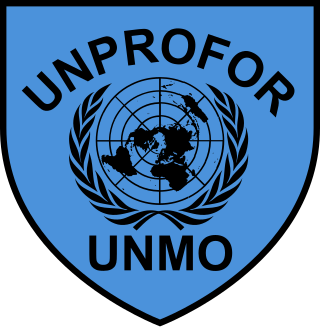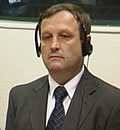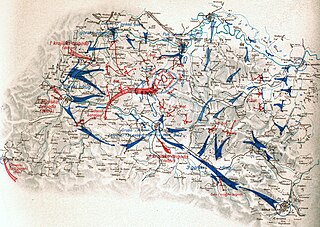Related Research Articles

Operation Storm was the last major battle of the Croatian War of Independence and a major factor in the outcome of the Bosnian War. It was a decisive victory for the Croatian Army (HV), which attacked across a 630-kilometre (390 mi) front against the self-declared proto-state Republic of Serbian Krajina (RSK), and a strategic victory for the Army of the Republic of Bosnia and Herzegovina (ARBiH). The HV was supported by the Croatian special police advancing from the Velebit Mountain, and the ARBiH located in the Bihać pocket, in the Army of the Republic of Serbian Krajina's (ARSK) rear. The battle, launched to restore Croatian control of 10,400 square kilometres of territory, representing 18.4% of the territory it claimed, and Bosniak control of Western Bosnia, was the largest European land battle since World War II. Operation Storm commenced at dawn on 4 August 1995 and was declared complete on the evening of 7 August, despite significant mopping-up operations against pockets of resistance lasting until 14 August.

The Yugoslav Wars were a series of separate but related ethnic conflicts, wars of independence, and insurgencies that took place from 1991 to 2001 in what had been the Socialist Federal Republic of Yugoslavia. The conflicts both led up to and resulted from the breakup of Yugoslavia, which began in mid-1991, into six independent countries matching the six entities known as republics that had previously constituted Yugoslavia: Slovenia, Croatia, Bosnia and Herzegovina, Montenegro, Serbia, and Macedonia. SFR Yugoslavia's constituent republics declared independence due to unresolved tensions between ethnic minorities in the new countries, which fueled the wars. While most of the conflicts ended through peace accords that involved full international recognition of new states, they resulted in a massive number of deaths as well as severe economic damage to the region.

The Republic of Serbian Krajina or Serb Republic of Krajina, known as the Serbian Krajina or simply Krajina, was a self-proclaimed Serb proto-state, a territory within the newly independent Republic of Croatia, which it defied, and which was active during the Croatian War of Independence (1991–95). It was not recognized internationally. The name Krajina ("Frontier") was adopted from the historical Military Frontier of the Habsburg monarchy (Austria-Hungary), which had a substantial Serb population and existed up to the late 19th century. The RSK government waged a war for ethnic Serb independence from Croatia and unification with the Federal Republic of Yugoslavia and Republika Srpska.

The Bosnian War was an international armed conflict that took place in Bosnia and Herzegovina between 1992 and 1995. The war is commonly seen as having started on 6 April 1992, following several earlier violent incidents. It ended on 14 December 1995 when the Dayton Accords were signed. The main belligerents were the forces of the Republic of Bosnia and Herzegovina, the Republic of Herzeg-Bosnia, and the Republika Srpska, the latter two entities being proto-states led and supplied by Croatia and Serbia, respectively.

The United Nations Protection Force was the first United Nations peacekeeping force in Croatia and in Bosnia and Herzegovina during the Yugoslav Wars. The force was formed in February 1992 and its mandate ended in March 1995, with the peacekeeping mission restructuring into three other forces.

The Croatian War of Independence was an armed conflict fought from 1991 to 1995 between Croat forces loyal to the Government of Croatia — which had declared independence from the Socialist Federal Republic of Yugoslavia (SFRY) — and the Serb-controlled Yugoslav People's Army (JNA) and local Serb forces, with the JNA ending its combat operations in Croatia by 1992.

Milan Martić is a Croatian Serb politician and war criminal who served as the president of the unrecognized Republic of Serbian Krajina, a self-proclaimed state largely populated by Serbs of Croatia that wished to break away from Croatia during the Croatian War of Independence.
Dvor is a municipality in the Banovina region in central Croatia. Administratively, it belongs to the Sisak-Moslavina County and is located across the Una River from Novi Grad in Bosnia and Herzegovina. Dvor is an underdeveloped municipality which is statistically classified as the First Category Area of Special State Concern by the Government of Croatia.
The Škabrnja massacre was the killing of 62 Croatian civilians and five prisoners of war by Serbian Autonomous Oblast Krajina Territorial Defence troops and the Yugoslav People's Army (JNA) in the villages of Škabrnja and Nadin east of Zadar on 18–19 November 1991, during the Croatian War of Independence. The massacre occurred shortly after an agreement to evacuate Zadar's JNA garrison following an increase in fighting between the Croatian National Guard and the JNA. Most of the killings were committed by SAO Krajina troops which followed the leading armoured JNA units fighting their way into Škabrnja on 18 November. During the initial attack, the attacking force employed a human shield of captured civilians forced to walk in front of armoured vehicles. Most of the civilian population fled the village and about 120–130 were captured by the JNA and detained in the village school and kindergarten. However, others who took shelter in basements were killed in or just outside their homes. A portion of those killed in the massacre were buried in a mass grave in Škabrnja, while dozens of bodies were turned over to Croatian authorities.
The Baćin massacre was the killing of 83 civilians just outside the village of Baćin, near Hrvatska Dubica, committed by Croatian Serb paramilitaries. The killings took place on 21 October 1991 during the Croatian War of Independence. Most of the civilians were Croats, but they also included two ethnic Serbs, taken from Hrvatska Dubica, Baćin and the nearby village of Cerovljani. The civilians were killed in the area of Krečane, at the very bank of the Una River, and their bodies were left unburied for two weeks. Most of them were subsequently bulldozed into a shallow mass grave, while a number of the bodies were thrown into the river. Further killings of Croat civilians continued in Baćin and surrounding areas until February 1992.

The Kozara Offensive, also known as Operation West Bosnia was a large-scale German-led counter-insurgency operation against the Yugoslav Partisans in the Bosnian mountain region of Kozara in the Independent State of Croatia during World War II. It was launched on 10 June 1942, with the goal to encircle and destroy the Partisans who were operating in the Kozara mountain region near Banja Luka, which threatened German access to the Belgrade-Zagreb railway.
Operation Mistral 2, officially codenamed Operation Maestral 2, was a Croatian Army (HV) and Croatian Defence Council (HVO) offensive in western Bosnia and Herzegovina on 8–15 September 1995 as part of the Bosnian War. Its objective was to create a security buffer between Croatia and positions held by the Bosnian Serb Army of Republika Srpska (VRS). The operation also spearheaded a Herzeg-Croat led move to compromise the occupation of the largest Bosnian Serb-held city, Banja Luka, by capturing the towns of Jajce, Šipovo and Drvar. Thus jeopardizing the operations capacity of Banja Luka and ultimately leading to its recapture. The combined HV and HVO forces were under the overall command of HV Major General Ante Gotovina.

During the Bosnian War, there was an ethnic cleansing campaign committed by the Bosnian Serb political and military leadership – Army of the Republika Srpska, mostly against Bosniak and Croat civilians in the Prijedor region of Bosnia and Herzegovina in 1992 and 1993. The composition of non-Serbs was drastically reduced: out of a population of 50,000 Bosniaks and 6,000 Croats, only some 6,000 Bosniaks and 3,000 Croats remained in the municipality by the end of the war. Apart from the Srebrenica massacre, Prijedor is the area with the second highest rate of civilian killings committed during the Bosnian War. According to the Sarajevo-based Research and Documentation Center (IDC), 4,868 people were killed or went missing in the Prijedor municipality during the war. Among them were 3,515 Bosniak civilians, 186 Croat civilians and 78 Serb civilians. As of October 2013, 96 mass graves have been located and around 2,100 victims have been identified, largely by DNA analysis.

The siege of Bihać was a three-year-long siege of the northwestern Bosnian town of Bihać by the Army of the Republika Srpska, the Army of the Republic of Serbian Krajina and Bosnian Muslim dissenters led by Fikret Abdić during the 1992–95 Bosnian War. The siege lasted for three years, from June 1992 until 4–5 August 1995, when Operation Storm ended it after the Croatian Army (HV) overran the rebel Serbs in Croatia and northwest of the besieged town.
The Paulin Dvor massacre was an act of mass murder committed by soldiers of the Croatian Army (HV) in the village of Paulin Dvor, near the town of Osijek on 11 December 1991 during the Croatian War of Independence. Of the nineteen victims, eighteen were ethnic Serbs, and one was a Hungarian national. The ages of the victims, eight women and eleven men, ranged from 41 to 85. Two former Croatian soldiers were convicted for their role in the killings and were sentenced to 15 and 11 years, respectively. In November 2010, Croatian President Ivo Josipović laid a wreath at the graveyard of the massacre victims and officially apologized for the killings.
Operation Stinger was an offensive undertaken by the forces of the SAO Krajina, an unrecognized Croatian Serb region opposing the Republic of Croatia, against positions held by the Croatian police in the region of Banovina on 26–27 July 1991, during the Croatian War of Independence. It was primarily aimed at police stations in Glina and Kozibrod, as well as police-held positions in a string of villages between the town of Dvor and Kozibrod. In addition to Glina and Kozibrod, heavy fighting took place in the village of Struga, north of Dvor, where Croatian Serb forces employed a human shield consisting of Croat civilians taken from their homes in Struga and the nearby village of Zamlača.
The Golubić killings was the mass murder of at least 18 Serb civilians from the village of Golubić in the county of Šibenik-Knin County on 6 August 1995, by members of the Croatian Army (HV) during Operation Storm.
The Gošić kllings refers to the mass murder of elderly Serb civilians from the village of Gošić in Šibenik-Knin County by members of the Croatian Army (HV) on 27 August 1995, approximately three weeks after Operation Storm.
The Grubori massacre was the mass murder of six Serb civilians from the village of Grubori, near Knin, on 25 August 1995 by members of the Croatian Army (HV) in the aftermath of Operation Storm. The massacre was listed in the ICTY's indictment of Croatian wartime generals Ante Gotovina, Ivan Čermak and Mladen Markač.
On 7 August 1995, two Croatian Air Force MiG-21 planes fired several rockets at a Serb refugee column on a road near Bosanski Petrovac, Bosnia and Herzegovina, killing 9 civilians and injuring more than 50. On 8 August 1995, another attack took place, resulting in more civilian casualties. The victims were traveling in a refugee column fleeing Croatia during Operation Storm which brought about an end to the Croatian War of Independence.
References
- 1 2 "RTS "postpones" documentary to protect Croats who made it". B92.net. RTS. 16 March 2016.
- 1 2 3 4 Bakotin, Jerko; Kosanovic, Sasa; Mulvad, Nils (8 August 2020). "Mystery of Croatian School Massacre Unsolved, 25 Years On". Balkan Insight.
- 1 2 3 4 5 6 Larsen, Georg; Vedsmand, Kasper (29 May 2016). "When the UN watched a massacre unfold in Croatia". AlJazeera.
- ↑ "15 minutes - The Dvor Massacre". Sarajevo Film Festival.